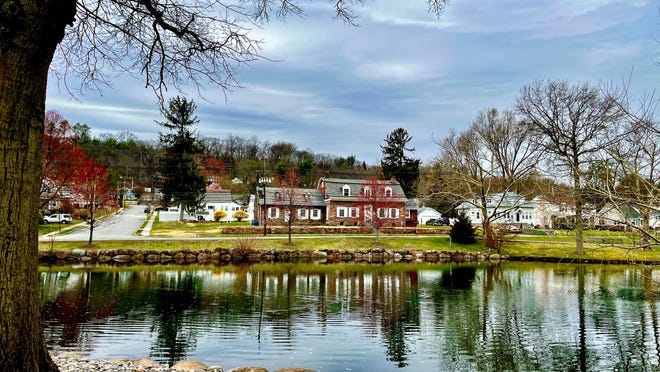
One of Hawthorne’s oldest homes, a brownstone overlooking Goffre Brook, has a story to tell.
The Van Winkle House at 868 Goffle Road, listed for sale in June for $950,000 by Jeff Vander Molen of Terry O’Connor Real Estate, is known as the site of Passaic County’s first murder. Built in the mid-18th century and expanded to its present size in the early 19th century, the four-bedroom, five-bathroom home wears its history like a badge of honor, bloodstains aside.
Exposed beams and stone feature throughout the interior, as do whitewashed paneling, chair rails and dark wood floors. The master suite features motorized window curtains and a sleek, modern bathroom. The office is a spacious, contemporary space with vaulted ceilings.

Vander Molen said the original parts of the house, including two rooms and a bathroom that were gutted, have professionally designed plans for the next owner, allowing for further modernization. New metal and wood beams in the basement bolster the home, which sits on a two-thirds-an-acre lot.
Most of the house was added to in 1811 by notorious murder victim and county judge John S. Van Winkle. Born in 1784, Van Winkle operated a farm and gristmill on 212.5 acres he inherited from his father, Simeon Van Winkle (aka Simeon of the Bogut), who lived in Paterson’s Riverside district, according to federal historical records. Looking to expand, Van Winkle and a neighbor successfully lobbied the state in 1828 to build a dam on the Passaic River to establish a profitable canal route, according to records.
According to county records, Van Winkle, a prominent resident and businessman in Passaic County, was appointed district court judge for the county when it was created in 1837. Things were going well for Van Winkle until January 1850, when a farm worker who had recently been released from prison broke into his home, stabbed him to death, and killed his wife with an axe.

According to city records, the house remained in the Van Winkle family’s possession until 1901, when it was rented out primarily to tenant farmers after the murders. The oldest part of the house was built of rubble between 1746 and 1774 by Van Winkle’s grandfather, also named John S. Van Winkle. Local records indicate that the construction date is unknown, but is believed to be 1761.
The large stone addition features a cornerstone dating to 1811, 39 years before the first recorded murder in Passaic County, which was the subject of Don Everett Smith Jr.’s book “Passaic County’s First Murder and Execution: The Van Winkles and Goffre Road Murders,” but has been a topic of conversation for decades in recent memory, according to city records.
170 years ago, Passaic County was shocked by its first murder and the public execution of the perpetrator.
According to Smith, the convicted killer was a 34-year-old Liverpool man named John Johnston, who had had Christmas dinner with the Van Winkle family just two weeks before the murders. Johnston used a ladder from Van Winkle’s flour mill to climb through a second-floor window and kill 61-year-old Janettje Van Winkle by hitting him twice with an axe in his bedroom. Johnston lost the axe after a scuffle with 65-year-old Van Winkle but pulled a knife, the Paterson Intelligencer reported a week after the murders. Johnston stabbed Van Winkle to death and fled the house.
Johnston was arrested a short time later at a train station in Ridgewood, then known as Godwinville, according to the Paterson Intelligencer. He was tracked down by footprints in the snow and found with a bloody bag. Van Winkle died 16 hours later, giving him enough time to plan his own funeral, Smith said.

Johnston was held in captivity for two months while awaiting indictment. He was found guilty, sentenced to death, and hanged in late April 1850. According to county records, this was the first of five executions in Passaic County history.
The end of the house where the murder occurred was sealed off for decades after the judge’s death, according to an August 1882 New York Times report. During that time, the ladder Johnston used to gain entry remained leaning against the side of the house, the paper reported.


